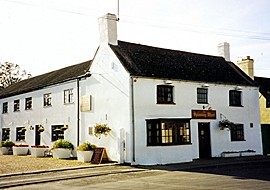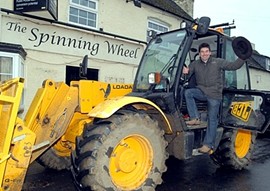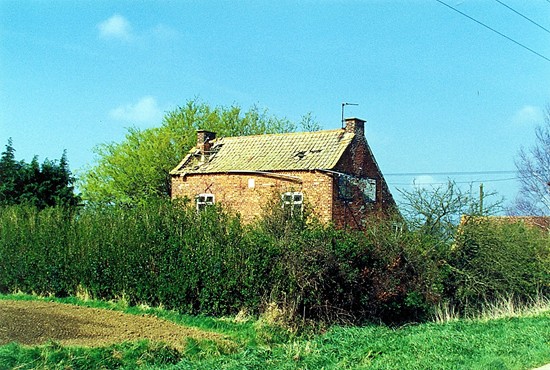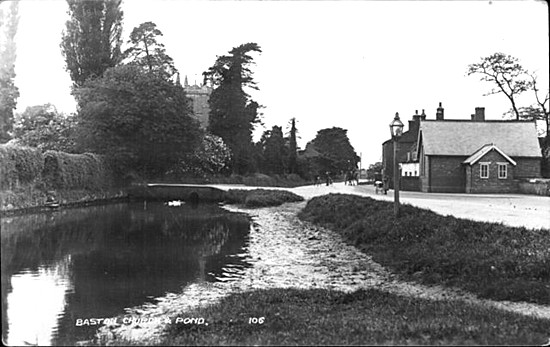|
Baston
A new village sign was erected at the approaches of Baston, four miles south of Bourne, to mark the new millennium and to welcome visitors to this historic fenland community lying between the road known as King Street, built by the Romans 2,000 years ago, and the canal called Car Dyke which they used to haul men and supplies to their armies in the north. The illustrated sign depicts scenes from the village's past and was planned and financed by the people who live here as a reminder that they are proud to be associated with Baston and acknowledge their heritage. The
village is referred to in the Domesday Book as Bascune and in 1257, a
charter was signed by Henry III granting villagers the right to hold a weekly
street market and a three day fair and feast on June 24 to mark the nativity of
St John, patron saint of the parish church, a tradition that has been revived in
recent years.
In the village are two wide and parallel streets with the mediaeval Church of St John the Baptist, much restored over the centuries, lying between them. The church has an Early English chancel arch although the chancel itself was rebuilt in 1860, otherwise it is mostly Perpendicular in style. This is one of the few churches in the Bourne area that is always open to the public during the day, although locked at night, and it is by far one of the best kept, clean and tidy and with fresh flowers to delight visitors. Entry to the church is by the 14th century south porch which has an elaborate niche above the entrance and a sundial which predates the imposing clock on the embattled tower. There is a pleasing simplicity about the white-walled interior with comic faces from the Middle Ages here and there and light streaming through unhindered from several windows, the Victorian east window being the most attractive and colourful. The pews, which can be seen in the foreground, were installed in 1851.
Methodism was established in Baston during the early part of the 19th century with 12 members in 1838 rising to 30 in 1848. A chapel was built in 1847 which lasted for thirty years until the present building was erected in 1877 at a cost of £849 11s. 5d., one of the most attractive and largest chapels in the area with accommodation for 300 worshippers. Unfortunately, the ceiling collapsed in January 1895 making the building unfit for services for several months until repairs were completed. Attendance dropped in the early years of the 20th century and the chapel was closed for a period during 1917-18 and again in 1930-31. There was an improvement in the numbers attending services but this was short-lived and the chapel closed for good in 1935 when the building was put up for sale. The trustees hoped to get £200 but accepted £130 and the building has been in commercial occupation ever since and is now used as a garage (pictured below left).
One of the more fashionable restaurants in the district can also be found here, namely the Baskervilles (pictured above right), named after the famous Sherlock Holmes novel by Sir Arthur Conan Doyle as the hound on the inn sign attests. The building dates from 1843 and a stone tablet on the front also carries the initials R S N, a custom that usually indicates the name of the original owner. There has been extensive rebuilding of the premises following a recent disastrous fire. The old corn mill at Baston survives, neglected but not forgotten, at Mill House Farm which is accessed by a turning from the main A15 road south of the village. It was built in 1806 and was known as Hudson's Mill, a tower mill that was worked until the Great War when it was dismantled and the machinery is thought to have been used for another mill elsewhere. It had four patent sails and probably drove two pairs of stones for grinding corn. The stone tower, once rendered, stands on a low mound, which suggests an older mill on the site, and is now virtually a shell with only a few floor beams remaining. Part of the cap frame lingers on at the top and in its later working life it lost one of its sails when a farm wagon came too close for comfort although all four have now gone. Mr Joe Brudenell's family have farmed in the South Fen around Baston since 1874 and bought the mill in 1916. It is now a Grade II listed building. In 2000, when Joe was aged 78, he had retired from the business which was run by his son Michael, although he still appeared at harvest time to drive a combine. But he was anxious to see the mill survive. "It would be a great loss to see it disappear completely", he said wistfully. "Perhaps the Millennium Fund might help us out. We must see what can be done."
At the far end of the village stands the manor house, an attractive building that looks its best in the late afternoon sunshine. Baston Manor dates back to the 17th century and is L-shaped, built of stone with some brick and stone bands on the north front. Part of the original moat borders the village street and there is a dovecote in the grounds dated 1802, yet looks 17th century. Close by are old stone barns with massive oak beams, one with the date 1795, and a flight of stone stairs to the loft. The finest room in the house is the great kitchen with massive beams and walls two feet thick while the ground floor drawing room on the right formerly had a blocked window which has been painted out. A recent owner, Mr F C Knipe, was born in the house over 70 years ago, his father having bought the manor in 1888 when he had 120 bullocks and 600 sheep. Previously Mr Robert Marriott had lived there until 1876. He was a horse-breeder who won many prizes at local agricultural shows. Over 300 blue rock pigeons were also kept in the dovecote in past times and were released for sport in the days before clay pigeon shooting. A pane of the left-hand ground floor window of the house has the words "John Cunnington, April 22nd 1811" scratched in the glass with a diamond and in another pane was a finely drawn man's head with long hair or a wig and the same name "John Cunnington, 1809".
During the mid-19th century, boys from the village were employed on farm work such as collecting turnips as part of the gang system but compulsory education introduced by the government required them to be educated and in 1863 a national public elementary school was opened. It was originally little more than a building with one room, financed mainly by the vicar, the Rev W C Denshire, who contributed £150 while Lord Willoughby de Eresby provided the site and other landowners, notably Lord Aveland and Sir John Trollope, made liberal donations. A schoolmaster was appointed and shortly before Christmas, two amateur concerts were held in the village to raise further funds. It was immediately popular with 80 scholars on the roll and the building was enlarged in 1875 at a cost of £150 and a further £97 was spent in 1889 to provide places for 160 boys and girls although the average attendance was 130 in 1910 when Mr Dent Wroe was master.
In January 1866, a parochial lending library was opened at Baston, one of the first villages in the area to have such a facility. It is believed to have operated from the schoolroom and donations of books and money were collected by the vicar and his churchwardens. The school remained in use until the second half of the 20th century when it was replaced by a modern building built on a new site and is known today as Baston Church of England Primary School.
There are extensive gravel workings on the outskirts of Baston village that have provided evidence that the locality was once the hunting ground of fearsome creatures between 10,000 and 20,000 years ago. In the summer of 1953, a visitor to the area was attracted by what appeared to be a lump of stone discarded by a lorry driver and expert examination established that it was the upper molar of a prehistoric mammoth elephant, weighing 10 lb. In the same year, another large object about 33 inches in length was recovered by a dragline and subsequently identified as the stump of the right tusk from a young mammoth elephant. It had an ivory appearance and weighed 14 lb. and, as with the molar, had petrified.
The Spinning Wheel public house in Church Street, Baston,
closed down in October 2012 despite a vigorous campaign by villagers to
save it for the community. The owners, the Charles Wells brewery,
eventually put the property up for sale it was bought by local farmer Mark
Richardson, aged 41, who gave the place a facelift and re-opened under the
old name of the White Horse. “I thought it was a great shame when the
place closed”, he said, “but when it went on the market I saw the
opportunity to turn the building back into the village pub it once was.”
Immediately inside the door of the village church at Baston is a unique oak chest circa 1350. For many years it stood scarcely noticed at the east end of the north aisle but in 1948 it was moved to its present position at the back of the church where it can be seen to advantage. The chest is made from wide riven heart of oak boards finished with an adze, and is 6 feet 9 inches long, 2 feet 9 inches high and 16 inches wide. The storage part is divided into two compartments, each fitted with a separate lid with two heavy iron hinges which span the full width of the lids and also wrap around the back, bottom and front. They are secured by iron nails clinched inside while every foot of its length is banded with iron. The two ends are also strapped with iron in both directions.
REVISED AUGUST 2015 See also Tornado hits Baston When Baston was threatened by chemical bombs
Go to: Main Index Villages Index |
|||||||||||||||||||||||||||||||||




















